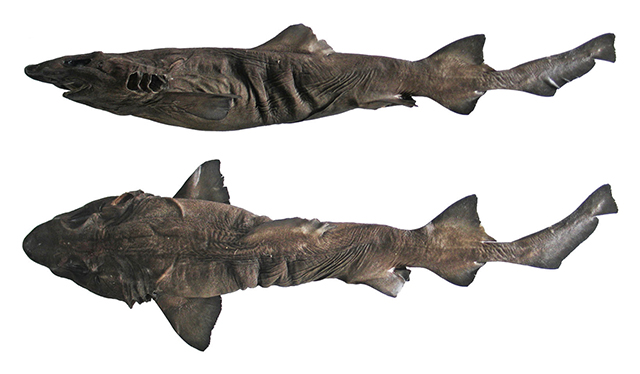| Pseudotriakidae (False catsharks) |
| 64 cm TL (male/unsexed) |
|
bathydemersal; marine; depth range 200 - 1000 m |
| Indian Ocean: India and Sri Lanka. |
|
This species is distinguished from its closest congener P. parini by the absence of oral papillae on the roof, tongue, and floor of mouth; no distinct white mark on the free rear tip of the first dorsal fin, sides, and underside of head, and fin edges that are similar in color as body (vs. dusky); greater number of tooth rows in the lower jaw (ca. 153-156 vs. ca. 115-120); shorter upper labial furrows (0.6-0.8 vs. 0.9-1.2% TL and 0.7 vs. 1.0-1.2 times as long as lowers), spiracles longer (1.6 vs. 0.9-1.2% TL) and less high (0.8-0.9 vs. 1.2-1.8% TL); proportionally higher, more angular dorsal fins, especially the second dorsal fin; proportionally longer pectoral fins, larger anal fin; longer precaudal (79.4-79.7 vs. 74.6-79.1% TL), pre-second-dorsal (62.7 vs. 56.6-60.5% TL), pre-first-dorsal (36.5-37.0 vs. 34.5-36.5% TL), prepelvic (52.7-53.4 vs. 47.2-51.4% TL), and snout-anterior vent (56.1-57.1 vs. 50.7-53.9% TL) lengths; shorter distances for preorbital snout (7.3-7.7 vs. 8.3-8.5% TL); prepectoral length (22.7-23.0 vs. 24.0-25.4% TL); pelvic midpoint to second dorsal fin origin (4.8-5.6 vs. 5.6-7.7% TL); pelvic-anal space (4.8-5.2 vs. 5.5-5.8% TL) (Ref. 119154). |
| Specimens were taken as bycatch in deep-sea longline fishery for gulper sharks (Centrophorus spp.) (Ref. 119154). |
|
Data deficient (DD); Date assessed: 21 November 2019 Ref. (130435)
|
| harmless |
Source and more info: www.fishbase.org. For personal, classroom, and other internal use only. Not for publication.

